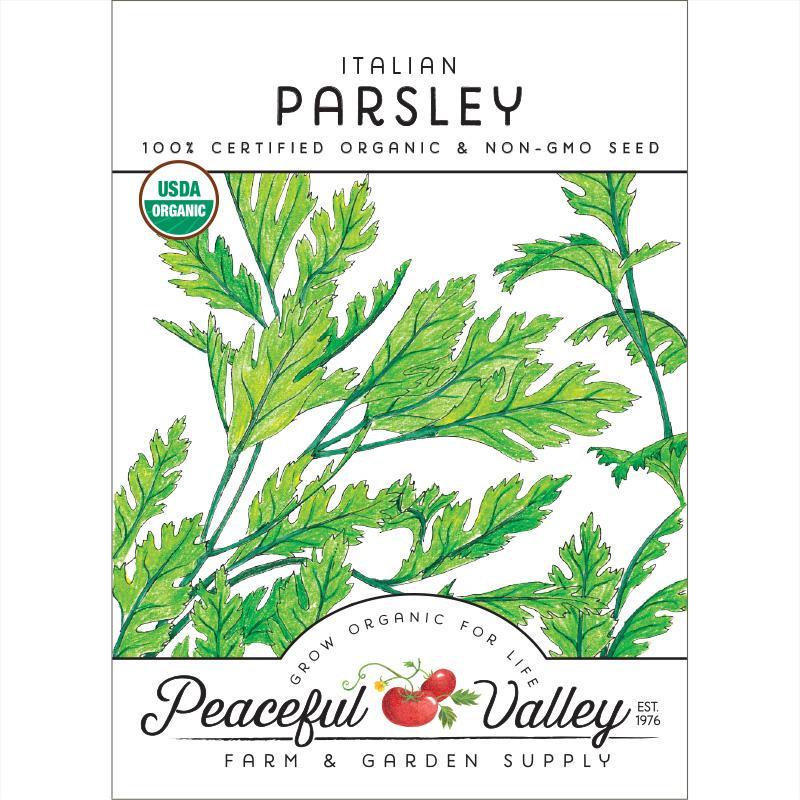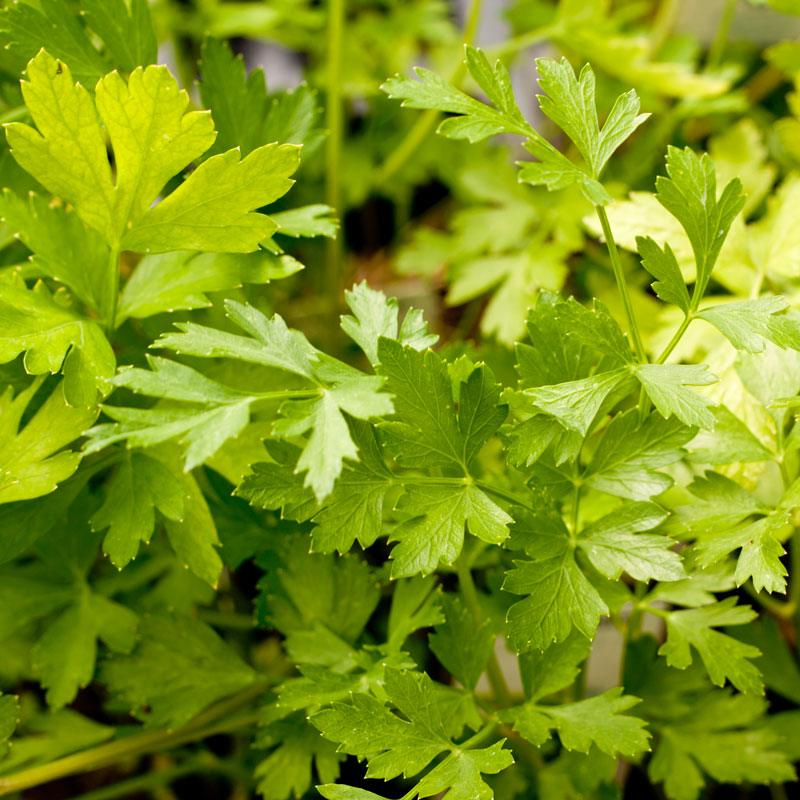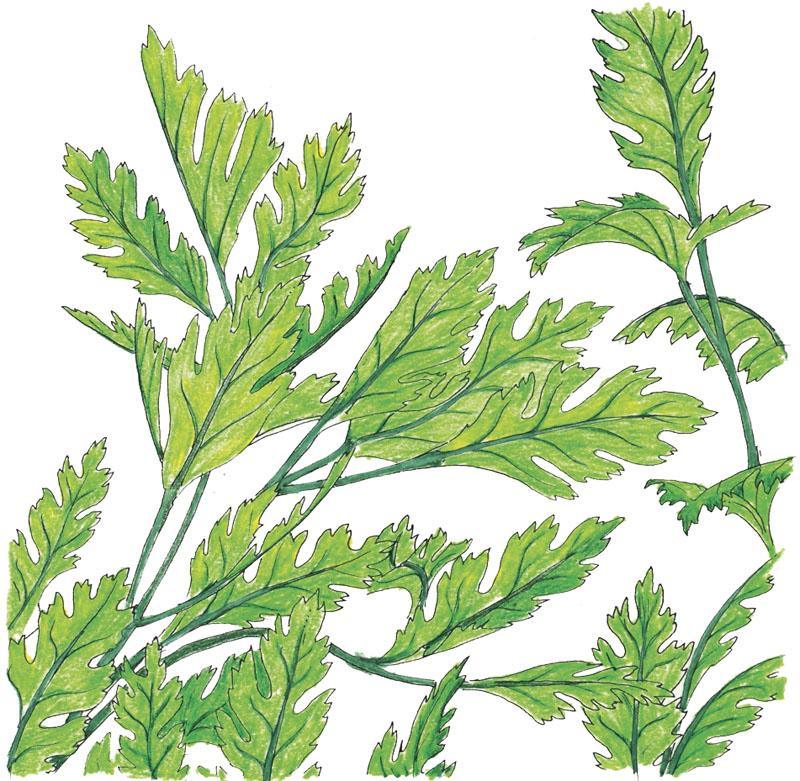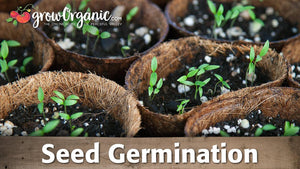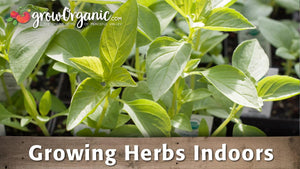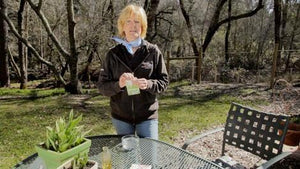Item Number: SNV8110
Italian Parsley Seeds (Organic)
Bold flavor, versatile herb.
Italian Parsley, often called flat-leaf parsley, is a kitchen essential and a gardener’s delight, prized for its bold, robust flavor and versatility in culinary applications. The deep green, flat leaves are tender and aromatic, making them perfect for garnishes, soups, sauces, salads, and marinades. Unlike curly parsley, Italian Parsley’s concentrated flavor enhances both raw and cooked dishes without overpowering other ingredients. This biennial herb thrives in full sun to partial shade and well-draining soil, reaching maturity in about 75-80 days. Italian Parsley grows upright, with vigorous, lush foliage that is easy to harvest and encourages continuous growth when picked regularly. It’s cold-tolerant and performs well in both spring and fall gardens, making it a reliable option for year-round use in many climates. Its adaptability also allows it to thrive in containers, raised beds, or garden borders. In addition to its culinary uses, Italian Parsley is rich in vitamins and minerals, adding nutritional value to every dish. Whether you’re a seasoned chef or a novice gardener, this hardy, low-maintenance herb is a must-have for its flavor, productivity, and ease of growth. Add Italian Parsley to your garden for a steady supply of fresh, vibrant greens.
Parsley - Italian - Petroselinum neapolitanum
Biennial Italian parsley is a glossy flat-leaf variety that is called for in many gourmet recipes. It's excellent for seasoning, with a stronger flavor than many curly types. It turns bitter when it bolts.
Did You Know? Parsley is rich in vitamins A, C, several Bs, and calcium and iron.
Soil Temperature: Soil Temperature: 65-85°F
Planting Depth: 1/4"
Germination: 14-25 Days
Height At Maturity: 10"-16"
Days To Maturity: 78-80 Days
Sun/Shade: Partial Sun
Spacing After Thinning: 6"
Approx Seeds per Pack: 250 | Per 1/4 lb bulk: 64,400 Seeds
Growing Italian Flat Leaf Parsley from Seed: A Comprehensive Guide
Introduction
Italian flat-leaf parsley, scientifically known as Petroselinum crispum, is a popular herb appreciated for its vibrant dark green, flat leaves and fresh, slightly peppery flavor. Unlike its curly counterpart, this variety of parsley is a staple in Mediterranean and Italian cuisine, offering a unique taste and versatility that enhances countless dishes. Whether you're a seasoned gardener or a novice with a green thumb, learning how to grow Italian flat-leaf parsley from seed can be a rewarding and enjoyable experience. In this guide, we will explore the steps and essential tips to cultivate robust and flavorful Italian parsley plants right in your own garden.
Selecting the Right Seeds
To embark on your journey of growing Italian flat-leaf parsley, the first step is to choose high-quality parsley seeds. Look for seeds that are fresh, well-packaged, and from a reputable source. Quality seeds are essential for ensuring successful germination and the development of robust parsley plants. Check the seed packet for the variety 'Italian flat leaf' or 'Petroselinum crispum neapolitanum,' as these are specifically the dark green, flat-leaved type.
Planting Italian Flat Leaf Parsley Seeds
- Timing: The ideal time to start growing Italian flat-leaf parsley from seed is in the spring or early summer when the soil has warmed up. In the United States, this typically means planting from late March to early May, depending on your local climate and growing zone.
- Container or Garden Bed: Decide whether you want to grow your parsley in a container or directly in your garden bed. Parsley is a versatile herb that can be grown in various settings. Ensure that your chosen location receives at least 6-8 hours of sunlight daily.
- Soil Preparation: Italian flat-leaf parsley prefers well-drained soil that is rich in organic matter. Loosen the soil in your chosen area or container and amend it with compost to improve fertility. Aim for a slightly acidic to neutral pH (around 6.0-7.0) for optimal growth.
- Sowing Seeds: Plant parsley seeds about 1/4 inch deep and space them approximately 2 inches apart in rows. If you are planting in a container, make sure it has sufficient drainage holes to prevent waterlogging.
- Germination: Parsley seeds can take some time to germinate, often up to three weeks. To speed up the germination process, you can soak the seeds in warm water for 24 hours before planting. Keep the soil consistently moist during this period.
Caring for Italian Flat Leaf Parsley
- Watering: Parsley prefers consistently moist soil but does not tolerate waterlogged conditions. Water your plants regularly, especially during dry spells, to keep the soil consistently moist but not saturated.
- Thinning: When your parsley seedlings have grown a few inches tall, thin them out to allow for proper spacing. Space the plants 6-8 inches apart to ensure good air circulation and minimize the risk of disease.
- Fertilization: Apply a balanced, all-purpose fertilizer to your parsley plants every 4-6 weeks throughout the growing season. Parsley benefits from a steady supply of nutrients to produce lush, dark green leaves.
- Mulching: Mulching around your parsley plants helps retain soil moisture, regulates temperature, and suppresses weeds. Use organic mulch like straw or compost to create a protective layer around the base of the plants.
- Pruning: Regularly trim or harvest the outer leaves of your Italian flat-leaf parsley to encourage new growth and maintain a continuous supply of fresh parsley. Be sure to use clean, sharp scissors or garden shears to prevent damage to the plants.
Harvesting Italian Flat Leaf Parsley
Italian flat-leaf parsley can be harvested once the leaves are large enough for your culinary needs. Here are some tips for harvesting and using your parsley:
- Timing: You can start harvesting parsley leaves when the plants have reached a height of 6-8 inches. Begin by snipping the outer leaves, leaving the inner ones to continue growing.
- Harvesting Technique: Use clean, sharp scissors or garden shears to cut the leaves near the base of the plant. Avoid pulling or yanking the leaves, as this can damage the plant.
- Continuous Harvest: Parsley is known for its ability to produce fresh leaves for an extended period. Regularly harvest the outer leaves to encourage new growth, and your parsley plant will provide a steady supply of fresh herbs.
- Storing Parsley: To keep your parsley fresh, place the harvested leaves in a plastic bag and store them in the refrigerator. Alternatively, you can chop and freeze the leaves in an airtight container for future use. Dried parsley can also be stored in a cool, dark place.
Cooking with Italian Flat Leaf Parsley
Italian flat-leaf parsley is a versatile herb that adds a burst of fresh flavor to a wide range of dishes. Its dark green leaves and slightly peppery taste make it a must-have ingredient in your kitchen. Here are some popular culinary uses for fresh Italian parsley:
- Garnish: Sprinkle freshly chopped Italian flat-leaf parsley over soups, salads, pasta dishes, and roasted vegetables to add a vibrant touch of color and flavor.
- Bouquet Garni: Create a bouquet garni by tying a bundle of parsley, thyme, and bay leaves together with kitchen twine. This herb bundle can be added to stews, sauces, and stocks to infuse them with flavor.
- Salsas and Sauces: Mix finely chopped parsley with olive oil, garlic, and lemon juice to create a simple yet delicious salsa verde. It also complements tomato-based sauces and gravies.
- Seasoning: Add chopped parsley to marinades, dressings, and vinaigrettes to enhance their taste and aroma.
- Herbed Butter: Combine softened butter with minced Italian parsley for a delightful herb-infused butter that can be used to flavor grilled meats, seafood, or roasted vegetables.
Growing Italian flat-leaf parsley from seed is a rewarding and straightforward process that can provide you with a steady supply of fresh herbs for your culinary adventures. With the right care and attention to detail, you can enjoy the bright green, slightly peppery leaves of this versatile herb in your kitchen throughout the growing season. From garnishing dishes to enhancing the flavor of sauces and soups, Italian flat-leaf parsley adds a fresh, aromatic touch to your culinary creations. So, roll up your sleeves, plant those seeds, and savor the delicious rewards of homegrown parsley.
Photo by Sarah Griffin-Boubacar




Check Your Zone Compatibility:
Compatible with your zone.
Growing Zone for

Our Guarantee To You
Since 1976, we've served our customers at every stage of growing. Please contact us at any time. We are happy to support and assist you.
Shipping Information
Shipping Information
Shipping Weight: 0.01 lb
Dimensions: 4.5"L x 3.25"W x 0.1"H
Features
Features
- Attracts Bees/Butterflies
- Container Compatible
- Does Not Require Support
- Greenhouse Compatible
- Open-Pollinated
- Requires Summer Water
- Somewhat Drought Tolerant
Characteristics
Characteristics
Planting & Care
Planting & Care
Soil & Water: Parsley prefers loose, moderately fertile soil with plenty of added organic matter. Water lightly.
Planting & Growing: Start seeds indoors 2-4 weeks before the last frost, or sow seed directly just before the last frost. Germination is slow. Presoaking seeds can increase rate and yield of germination.
Harvesting & Storage: Harvest leaves and stems once they are large enough. Parsley flavor improves with successive cuttings. You can also harvest the whole plant, cutting at the soil level, and it will regrow. Pot up a plant for indoor, winter production.
Useful Information
Useful Information
Guarantee
Guarantee

Peaceful Valley Farm & Garden Supply brand vegetable seeds are guaranteed to germinate. Once the seeds have sprouted, please understand that Peaceful Valley cannot be held responsible for the many uncontrollable growing and climatic conditions that must be met to ensure the success of your crop(s).
Share
